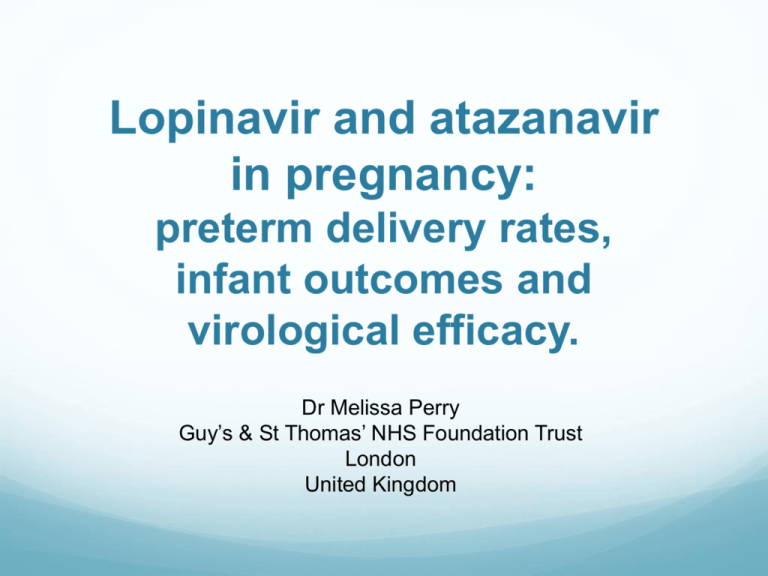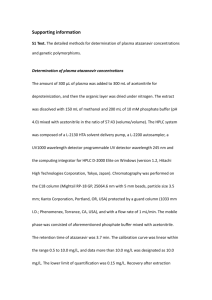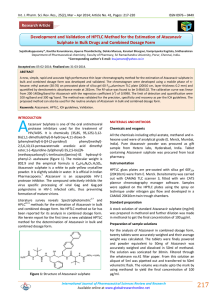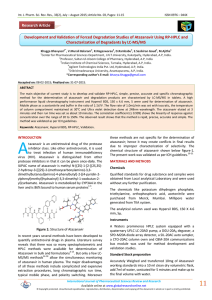Powerpoint
advertisement

Lopinavir and atazanavir in pregnancy: preterm delivery rates, infant outcomes and virological efficacy. Dr Melissa Perry Guy’s & St Thomas’ NHS Foundation Trust London United Kingdom Townsend et al CROI 2013 poster 906 What we know? Excellent ART coverage Excellent PMTCT Preterm delivery concerns Drug or drug class? Timing of ART? Lorenzi P, Spicher VM, Laubereau B et al. Powis KM, Kitch D, Ogwu A et al. European Collaborative Study AIDS 1998; 12: F241–F247 Tuomala RE,14: Shapiro DE,506–514. Mofenson LM et al. JAIDS Infect Dis 2011; 204: 2000; 2913–2930. European Collaborative N Engl J Med 2002; 346:Study. 1863–1870. European Collaborative Study. J Acquir Immune Defic Syndr 2003;32: 380– Tuomala RE,18: Watts DH, Li D et AIDS 2004; 2337–2339. 387. Kesho Bora Study Group, deal.Vincenzi I. JLancet Acquir Immune Defic Syndr Cotter AM, Garcia AG, Duthely ML Infect Dis 2011; 11:M2005;38:449–473. 171–180. Townsend CL, Cortina-Borja et alet al JAIDS Infect Dis 2006; 193: 1195–1201. 2007; 21: 1019–1026. Kourtis AP, Schmid CH, Jamieson DJ, Lau J. Schulte J, Dominguez K, Sukalac T et al AIDS 2007;21: 607–615 Townsend CL, Willey et al. Pediatrics 2007; 119: BA e900–e906. AIDS 2009; 23: 519–524. Association between ART and PTD Association between PI-based ART and Association between ART and PTD PTD No Association between ART and PTD - particularly marked in patients on PI’s Association between ART and PTD Association between ART and PTD -No particularly marked in patients PI’sPTD No Association between ARTonand and PTD Association between ART Association between and on PTD 1.5-fold increased riskART of PTD ART only if ART included a PIPTD and PI- -No association between No Association between PTD and containing AssociationART between ART and PTD PI-containing ART Association - only if ARTbetween includedART a PIand PTD www.bhiva.org As per HIV treatment guidelines for non pregnant individuals - based on VL, CD4 & genotype Conceive on ART remain on the same ART* Commencing ART for maternal health start ART ASAP All women should commence ART by 24W* No recommended dose adjustments. Therapeutic drug monitoring - only consider. In clinical practice: Two most commonly used PIs in pregnancy in the UK are ritonavir-boosted lopinavir and ritonavir-boosted atazanavir Our Question? Atazanavir or lopinavir in pregnancy? Outcomes Pre term delivery Infant outcomes transmission birth weight phototherapy requirement birth defects Tolerability and viral response clinical and virological aspects Retrospective case note review 9 London HIV specialist care centres All pregnancies commenced on atazanavir or lopinavir or conceived on atazanavir or lopinavir delivered 1st Sept 2007 - 30th Aug 2012 Results n=493 pregnancies Median age 33 years Ethnicity 81% Black African. HIV acquisition 97% through heterosexual exposure 0.6% from injecting drug use Hepatitis co-infection Hep B – 4% Hep C – 1% Use of Lopinavir vs. AtazanavirAtazanavir in Pregnant women overLopinavir time Total number of patients: 187 14 306 A t az anavir Lo p inavir Number of patients 12 10 8 6 4 2 0 S e pt 0 7 - A ugus t 12 NRTI Backbone Lopinavir Atazanavir 7% Truvada 6% 8% Com bivir 20% 24% Kivexa Other 3% 70% 62% % on standard dose Atazanavir 88% Lopinavir 92% Numbers of patients Atazanavir Lopinavir Total 95 82 177 Post conception 92 224 316 Total 187 306 493 Conceived on % of women who delivered <37W Atazanavir Lopinavir p-value Overall: 19 (13%) 40 (14%) ns Conceived on 11 (15%) 8 (12%) 0.98 Post conception 16 (20%) 24 (12%) 0.12 *8 percent (1 in 13) of general population UK live births are born preterm Infant outcomes Transmissions Atazanavir Lopinavir 1 (0.7%) 1 (0.4%) Overall MTCT rate: 0.5% % requiring phototherapy 2 (2%) 2 (1%) Birth defects (Conceived on) 3 (3%) 2 (2%) % <2500g birth weight 23 (15%) 40 (15%) Tolerability / toxicity Conceived on Post conception Atazanavir Lopinavir 2 (2%) 5 (6%) 5 (5%) 24 (11%) 55% related to nausea & vomiting Viral load decay Atazanavir Lopinavir Gestation (at starting ART) 20w 22w % VL<=50 cps/ml at delivery 85% 81% Median days VL <= 50 cps/ml 56days 43days 0.61 0.52 (despite the majority of women on ATV/r receiving the standard 300/100mg dose and co-prescribed tenofovir.) Conclusions Both regimens were successful in preventing MTCT No significant difference between ATV/r and LPV/r in preterm delivery rates infant outcomes tolerability and toxicity virological efficacy The PTD rates were comparable to those reported in previous studies and more favourable than others Limitations •Retrospective case note review •Small case numbers •Lacks power •Limited scope for multivariable logistic regression analysis Summary This is the first study comparing pregnancy outcomes between these two PIs. This study suggests both PI regimens at standard dosing are comparable in terms of virological efficacy, preterm delivery rates and infant outcomes. Disclosure I have received travel grants from Abbott, Boehringer Ingelheim, ViiV, Gilead. Authors & Affiliations Melissa Perry1, Katie Conway1, Caroline Sabin2, Stuart Flanaghan3, Ellen Dwyer4, Stevenson J4, Larissa Mulka5, Anna McKendry6, Elizabeth Williams8, Alison Barbour10, Sherie Roedling6, Rimi Shah7, Jane Anderson3, Mette Rodgers4, Chris Wood8, Liat Sarner9, Phillip Hay10, Graham Taylor5, Annemiek DeRuiter1. 1Guys and St Thomas NHS Foundation Trust. 2Department of Infection and Population Health, Division of Population Health, UCL Medical School. 3Homerton 4Croydon 5Imperial 6Central 7Barnet 8The University Hospital. College Healthcare NHS Trust. and North West London NHS Foundation Trust. and Chase Farm hospital NHS trust. North Middlesex University Hospital NHS Trust. 9Barts 10St University Hospital NHS Foundation Trust. Health NHS Trust. Georges Healthcare NHS Trust Questions?






